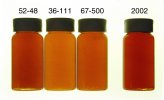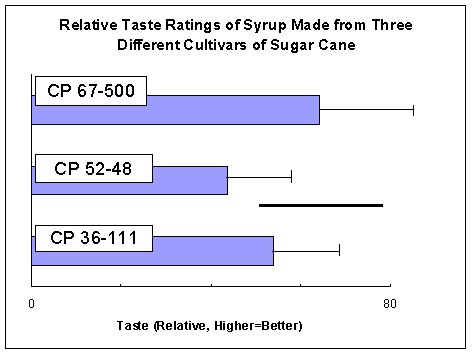|
Syrup From Different
Cultivars
Typically,
the extension services recommend C.P.
36-111, C.P. 52-48, and C.P. 67-500 as cultivars for
syrup production; the University
of Florida also recommends Louisiana Ribbon, Louisiana
Purple, and Louisiana Striped.
I have observed that excellent syrup is also
produced from C.P. 29-116 (“Yellow Gal”), from a large
soft purple variety (perhaps the purple variety that Wiley
(1902) described or (?) perhaps Louisiana Purple (said by Yoder
(1925) to be the prevalent syrup cultivar in south Georgia
and north Florida) or C.P. 31-511, a chewing variety) and
from others. One’s
selection of a cultivar is, in the end, a matter of
personal preference, tradition, and adaptation to a
particular region. Notwithstanding,
it is instructive to read Broadhead
and Zummo. They
indicate that “a suitable variety should produce a
high-quality syrup with the following characteristics:
light amber color; mild, sweet flavor typical of
sugarcane syrup; no colloidal sedimentation, or sediment
confined to a trace of small particles near the top of the
container; no crystallization or, if present, limited to a
few small crystals.”
In other places within the same bulletin, they
discuss other desirable cultivar traits that primarily
concern production (e.g., disease resistance, good
stubbling, resistance to lodging, sufficiently early
maturity, large-diameter soft stalks for efficient juice
extraction, high brix, and high yield.).
Undoubtedly, readers will take exception to some of
the characteristics embraced by Broadhead and Zummo, as I
do.
I
did not have the resources or desire to conduct a
professional variety trial, but I was interested in making
comparisons for my own purposes, implying that it should
be grown on my own soil.
In the end, I found, as expected, that the three
cultivars all have merit.
My final impressions were based on discussions with
knowledgeable growers, samples of different syrups, and a
cursory trial of my own for color
and taste,
which I will report here.
The
cultivars (C.P. 36-111, C.P. 52-48, and C.P. 67-500) were
grown side-by-side; fertilization was primarily by a
low-nitrogen formulation used for tobacco.
Syrup from each cultivar was produced on the
stovetop in a large stainless steel pot, a process that
required about 2 hours per batch.
Syrup was skimmed during processing and the final
product was strained through four layers of cheesecloth as
in some large-scale productions. As a reference, syrup (“2002”) made from a mixture of
these three cultivars plus a purple variety was prepared
in the traditional way in a cast-iron kettle.
Color
Without
question, legions of sugar chemists throughout the world
must know the precise molecular nature of the coloring
matter in syrup because they must deal with the same
compounds when they partition massecuite into crystals and
molasses. Surprisingly,
however, I could find very little when I searched
exhaustively in the public domain (Agricola
[the National Agriculture Library’s electronic data base
of citations] and ISI’s Web of Knowledge [available only
by subscription]). The
questions are two-fold, providing synergistic answers.
What is the material, and how does one enhance it
or diminish it? As
it turns out, the coloring matter is not one single
compound or simple. Tu
and Kondo (J. Chromotography 81:
187-189) indicate two heterogenous mixtures.
One is a brown mixture with a Mr ranging above
5000; the other is a brown to yellow mixture ranging
between 150-350. These
authors cite their previous work indicating that leaves
and the upper portion of the cane is the major source of
the high Mr mixtures.
Corroboratively, Yoder (USDA Bulletin 1034, 1925)
indicates that immature cane cannot produce clear and
light-colored syrup.
I speculate that this higher molecular weight
mixture consists of higher order polyphenols and early
chemists (Schneller, Louisiana Bulletin 157, 1916) showed
that immature portions of cane contain the bulk of
polyphenolics. Polyphenolics
can impart color on their own (as in browning of a cut
apple), but they can also react with other substances,
notably iron, to impart color.
Different cultivars vary in iron content (Fort and
McKaig, USDA Technical Bulletin 688, 1939) and intense
milling increases the iron content of the juice (Fort and
McKaig op. cit.). The
short story seems to be that immature cane and high
extraction rates, as mentioned by Paine and Walton (USDA
Bulletin 1370, 1925), contribute to color.
Paine
and Walton (op. cit.) as well as Dale and Hudson (USDA
Bulletin 921, 1920) warn against particles of bagasse in
the juice, claiming that it might scorch during syrup
production and impart color.
Spencer (Florida Ag Bulletin 118, 1913)
particularly stresses removing particles from the juice
(wire screen, cloth strainer, muslin, then woolen
blanket). Arkansas
Bulletin No. 22 (1892) even goes a step further and
suggests filtration of the juice through a 5-foot box of
straw in order to produce a light-colored syrup.
Indeed, Stockbridge (Florida Ag Bulletin No. 44,
1898)) evaluated a range of filtering substances
(cotton-lint, shaving, . . .) and recommended Spanish moss
as the best material to remove coloring matter from the
juice. Texas
Ag Bulletin 68 (1903) also used Spanish moss (a half
barrel, washed and scalded each day) to remove color from
juice. With
all this emphasis on cleaning the juice to produce
light-colored syrup during the heyday of syrup making, it
is a bit odd that most present-day syrup makers pay little
attention to this step.
Absolute and strict removal of all cell-wall debris
will also prevent formation of some colloids in the syrup
(mainly from pectin and pentosans (“hemicelluloses,”
see Sugar Technology Series No. 1, Imperial College of
Tropical Agriculture, Trinidad, 1929).
Caramelization
(“burning sugar”) is another source of color (Dale and
Hudson, op. cit.). Caramelization
can be diminished by avoiding hot surfaces with dried
juice or semi-syrup.
 Slide
1 shows the four syrup samples in liquid-scintillation
vials that were illuminated from the backside.
(All samples were clear, but the vials had dust on
the outside.) C.P.
36-111 made the lightest syrup, with C.P. 67-500 running a
close second. Slide
1 shows the four syrup samples in liquid-scintillation
vials that were illuminated from the backside.
(All samples were clear, but the vials had dust on
the outside.) C.P.
36-111 made the lightest syrup, with C.P. 67-500 running a
close second.
Taste
Six
subjects, representing both genders and two ethnic groups,
evaluated the taste of the syrup samples in a blind test
conducted in isolation. All subjects were consumers of sugar-cane syrup and professed
a fondness for it. Each
subject rated five unidentified syrup samples (one each of
the four syrups plus a duplicate of one of the samples) on
a 100-point scale, with 100 points being the best.
Scores for each subject were normalized to 50, and
then the normalized scores for each syrup were evaluated (Figure
2). The
dark bar in Figure 2 is the standard deviation of the
differences in scores given to the same syrup by the same
subject; interestingly, one subject rated the very same
syrup as the best and the worst of the lot and the
difference between those scores was a whopping 53 points.
In broad terms, this means that samples that did
not differ in score by more than 18 points were probably
indistinguishable to the subjects. Syrup made from C.P. 67-500 had the highest average score,
64, and was “better” (p~0.05, t-test, 1-tailed, equal
variance) than that made from C.P. 52-48, which averaged
44 points. The
data “suggested” that C.P. 36-111 syrup is also better
than CP 52-48 syrup (p~0.12).
Syrups of C.P. 36-111 and C.P. 67-500 were
indistinguishable statistically.

In
conclusion, C.P. 36-111 produced syrup slightly lighter
than C.P. 67-500 and these two cultivars were favored in a
small tasting by sugar-cane syrup aficionados.
|